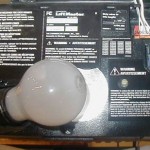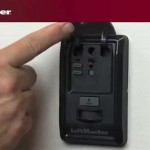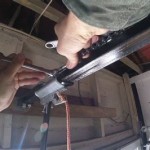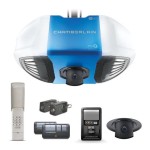PDS 370 Garage Door Opener: A Comprehensive Overview
The PDS 370 garage door opener represents a specific model within the landscape of residential and commercial garage door operating systems. Understanding its characteristics, capabilities, and limitations is crucial for homeowners, installers, and maintenance professionals alike. This article aims to provide a detailed examination of the PDS 370, covering its core features, operational mechanics, common issues, and maintenance requirements.
The garage door opener is a complex electromechanical device designed to automate the opening and closing of a garage door. It typically comprises an electric motor, a drive mechanism (such as a chain, belt, or screw drive), a control board, safety sensors, and a remote control system. The PDS 370 model, like other garage door openers, is engineered to provide convenience and security by eliminating the need for manual operation of the garage door.
Key Features and Specifications of the PDS 370
The PDS 370, depending on its specific iteration and manufacturer specifications, exhibits a range of features that define its performance and suitability for different garage door types. Core components often include a ½ horsepower motor, which is generally sufficient for standard residential garage doors made of lightweight materials like aluminum or steel. The motor’s power dictates the maximum weight and size of door it can effectively operate; exceeding these limitations could result in premature motor failure and compromised performance.
Drive mechanisms are another critical feature. The PDS 370 could employ a chain drive, belt drive, or screw drive system. Chain drives are known for their durability and cost-effectiveness but tend to be noisier than belt drives. Belt drives offer quieter operation, making them a preferable option for homes with attached garages where noise transmission is a concern. Screw drives, while less common, feature a direct linear motion, resulting in fewer moving parts and potentially lower maintenance requirements. The choice of drive mechanism impacts the operational noise level, longevity, and maintenance demands of the opener.
Modern garage door openers incorporate several safety features to prevent accidents and injuries. The PDS 370 is likely equipped with safety sensors, also known as photoelectric eyes, positioned near the bottom of the door opening on either side. These sensors project an invisible infrared beam across the doorway. If an obstruction breaks this beam while the door is closing, the opener immediately reverses direction, preventing the door from closing on the obstruction. This is a critical safety feature mandated by safety regulations. The PDS 370 will also often include a force adjustment system that allows the operator to set the amount of force required to open and close the door. This feature prevents the opener from continuing to attempt to close the door if it encounters an obstruction, even if the safety sensors fail.
Remote control functionality is a standard feature of the PDS 370. The opener typically includes one or more remote control transmitters that allow the user to operate the door from a distance, such as from inside a vehicle. These remotes communicate wirelessly with the opener's receiver using radio frequency (RF) signals. Rolling code technology is often incorporated to enhance security by changing the access code each time the remote is used, preventing unauthorized access by intercepting and replicating the signal. The frequency of operation is also a key specification influencing the range and reliability of the remote controls. A wall-mounted control panel, usually located inside the garage, provides an alternative means of operating the door and may include additional features such as a light control button and a lock button to disable the remote controls for added security.
Operational Mechanics and Programming
The operational mechanics of the PDS 370 garage door opener depend on the specific type of drive mechanism it employs. In a chain drive system, the motor rotates a sprocket that drives a chain connected to a trolley. The trolley, in turn, is attached to the garage door via a drawbar. As the chain moves, it pulls or pushes the trolley along a track, raising or lowering the door. In a belt drive system, the same principle applies, but a reinforced belt replaces the chain, resulting in quieter operation.
Screw drive systems utilize a threaded steel rod that rotates, moving a carriage along the rod to raise or lower the door. This design simplifies the mechanical components and can potentially reduce maintenance. The motor's rotational speed and gear ratio determine the door's opening and closing speed. Adjustable limit switches are used to define the upper and lower travel limits of the door, ensuring it stops at the correct positions without overrunning or damaging the door or the opener. These limits need to be programmed during installation and may require adjustment over time due to cable stretching or other factors.
Programming the PDS 370 garage door opener involves setting the travel limits, adjusting the force settings, and syncing the remote controls. The process typically requires accessing the control panel on the opener unit and following a specific sequence of button presses, as outlined in the operator's manual. Setting the travel limits ensures the door opens and closes to the desired positions without binding or causing damage. The force settings are crucial for safety, as they determine the sensitivity of the opener to obstructions. Incorrect force settings can lead to the door continuing to close even when encountering an object, posing a safety hazard. Syncing the remote controls involves pairing the remote transmitter with the opener's receiver, allowing the remote to send signals that the unit recognizes. This often involves pressing a "learn" button on the opener and then pressing a button on the remote to transmit the unique code. The specifics of these programming steps vary depending on the PDS 370 sub-model and manufacturer.
The control board serves as the electronic brain of the garage door opener, managing the motor operation, safety sensor responses, and remote control communication. It interprets signals from the various inputs and controls the motor accordingly. Diagnostic LEDs on the control board often provide visual indications of the system's status, helping to identify potential problems. For example, a flashing LED might indicate a misalignment of the safety sensors or a fault in the motor circuit.
Common Issues and Troubleshooting
Like any mechanical and electronic device, the PDS 370 garage door opener can experience various issues over time. One common problem is the failure of the safety sensors. If the sensors are misaligned, obstructed, or damaged, the opener will not close the door or may reverse direction. Cleaning the sensor lenses and ensuring they are properly aligned is crucial for troubleshooting this issue. Another issue is a malfunctioning remote control. This could be caused by a dead battery in the remote, interference from other electronic devices, or a problem with the opener's receiver. Replacing the battery, checking for interference, and reprogramming the remote can often resolve this issue.
Motor problems can also occur, such as the motor failing to start, running intermittently, or making unusual noises. These issues could be due to a faulty capacitor, worn-out motor brushes, or a problem with the control board. Replacing the capacitor or brushes may resolve some motor issues, but more complex problems may require replacing the entire motor or control board. Drive mechanism problems, such as a broken chain or belt, a stripped screw, or a loose trolley, can impede the door's movement. Replacing the damaged components and ensuring proper lubrication of the drive mechanism are essential for addressing these issues.
Limit switch malfunctions can cause the door to open too far, not open fully, or reverse direction unexpectedly. Adjusting the limit switches according to the operator's manual can resolve these issues. Power outages can also affect the operation of the garage door opener. Many modern openers have a battery backup feature that allows the door to operate during power outages, but the battery may need to be replaced periodically. In the absence of a battery backup, the door can be manually disengaged from the opener by pulling the emergency release cord. It is important to re-engage the door with the opener once power is restored. Regular inspection of the garage door and opener system is crucial identifying potential problems early to avoid major repairs.
Maintenance and Longevity
Proper maintenance is crucial for extending the lifespan and ensuring the reliable operation of the PDS 370 garage door opener. Regular lubrication of the moving parts, such as the chain, belt, or screw, is essential for reducing friction and wear. Using a garage door lubricant or white lithium grease is recommended. Inspecting the safety sensors regularly and cleaning the lenses helps ensure they function properly. Tightening any loose bolts or screws can prevent vibrations and potential damage. Checking the door's balance is also important. A properly balanced door should stay in place when opened halfway and released. An unbalanced door puts undue strain on the opener, shortening its lifespan.
Replacing worn parts, such as the chain, belt, or rollers, as needed can prevent more significant problems. Inspecting the wiring and connections for any signs of damage or corrosion is also important. Keeping the area around the opener clean and free of debris can prevent dust and dirt from accumulating and affecting its performance. These routine maintenance tasks, when performed regularly, can significantly extend the life of the PDS 370 and minimize the risk of unexpected breakdowns.
The longevity of the PDS 370 garage door opener depends on several factors, including the frequency of use, the quality of installation, and the level of maintenance. A well-maintained opener used in a typical residential setting can last for 10 to 15 years or even longer. However, openers subjected to heavy use or installed improperly may have a shorter lifespan. Choosing a qualified installer and following the manufacturer's recommendations for maintenance are essential for maximizing the longevity of the PDS 370. Furthermore, promptly addressing any minor issues, such as a squeaky chain or a slow opening speed, can often prevent them from escalating into more significant and costly problems.

New Garage Door Opener Service Installation Replacement

Precision Garage Door Openers Lehigh Valley Installation

Precision Garage Door Openers Riverside Liftmaster Installation

Precision Garage Door Openers Serving Portland Or Vancouver Wa

Precision Garage Door Openers Salt Lake City Liftmaster Replacement Installation

How To Program Precision Garage Door Key Pad Remote

Precision Door Service 14865 Sw 74th Ave Ste 160 Portland Or 97224 Us Mapquest

Choosing A New Opener Precision Garage Door

Garage Door Zone Blog Marantec Synergy 370 380 Operators Programming A Remote

Precision Garage Door Openers Riverside Liftmaster Installation
See Also








